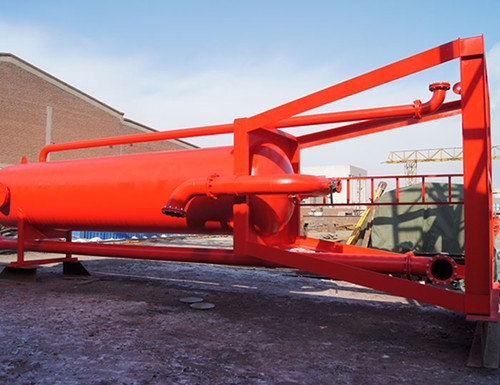
The field-proven Dachuan MUD/GAS SEPARATOR unit is an extremely reliable, vital piece of safety equipment for today's drilling operations.
It is ideal for use where drilling is likely to encounter large volumes of gas, sour gas or when an operator is drilling with an underbalanced mud column. The MUD/GAS SEPARATOR is primarily used to separate and safely vent large pockets of free gas, that may include toxic gases such as hydrogen sulfide, from the drilling-fluid system.
How It Works
The Dachuan MUD/GAS SEPARATOR system consists of a cylindrical pressure vessel in a fixed vertical position. Inside is a series of specially angled baffle plates, stepped from the top to the bottom.
When contaminated mud is routed into the separator, it flows downward successively over each plate. During this process, the heads of entrained gases “break out.” The released gas is then carried by the vent lines to a remote location where it can be safely flared.
The flow of liquid from the vessel can be regulated by a liquid-level-control valve or a U-tube, ensuring adequate retention time in the separator for the gas to break out.
The gas delivery from the MUD/GAS SEPARATOR unit to the flare line can be controlled by a back-pressure manifold (valve) in the flare line. The Dachuan MUD/GAS SEPARATOR unit is ideal to assist in controlling dangerous, near-surface expansion and accumulation of gas during a well kick.
Principle of Operation
The operating principle of a mud/gas separator is relatively simple. The device is essentially a vertical steel cylindrical body with openings on the top, bottom, and side. The mud and gas mixture is fed into the separator inlet and directed at a flat steel plate perpendicular to the flow. This impingement plate minimizes the erosion wear on the separator's internal walls and assists with mud/gas separation. Separation is further assisted as the mud/gas mixture falls over a series of baffles designed to increase the turbulence within the upper section of the vessel. The free gas is then vented through the gas vent line, and mud is returned to the mud tanks.
Operating pressure within the separator is equal to the friction pressure of the free gas venting through the vent line. Fluid is maintained at a specific level (mud leg) within the separator at all times. If the friction pressure of the gas venting through the vent line exceeds the mud-leg hydrostatic pressure within the separator, a blow-through condition will result in sending a mud/gas mixture to the mud tanks. As one can readily see, the critical point for separator blow-through exists when peak gas flow rates are experienced in the separator. Peak gas flow rates should theoretically be experienced when gas initially reaches the separator.
Features
■Highly efficient baffling system maximizes mud/gas separation while minimizing mist carryover and gas-cut mud at the flow line
■Designed for constant underbalanced drilling
■Corrosion-resistant, epoxy coated to ensure long life
■Versatile configuration
Benefits
■Optimizes safe drilling practices
■Enables more efficient separation of emulsions and gas-cut mud in either oil or gas environments
■Minimizes gas-cut mud and mist carryover
■Can be raised or lowered for flow-line adjustments to minimize piping
We are a mud gas separator supplier. Please feel free to contact us if you need them!
 Linear Motion Shale Shaker In Drilling Rig
Linear Motion Shale Shaker In Drilling Rig  Oilfield Mud Cleaner
Oilfield Mud Cleaner  Drilling Fluid Decanter Centrifuge
Drilling Fluid Decanter Centrifuge  Drilling Mud Desander
Drilling Mud Desander  Hydrocyclone Desilter
Hydrocyclone Desilter  Centrifugal Pump/Centrifugal Mud Pump
Centrifugal Pump/Centrifugal Mud Pump  Shear Pump
Shear Pump  Jet Mud Mixer
Jet Mud Mixer  Horizontal Mud Agitator
Horizontal Mud Agitator  Constant Pressure Drilling Fluid Mud Gas Separator
Constant Pressure Drilling Fluid Mud Gas Separator  Mud Gun
Mud Gun  Mud Tank
Mud Tank  Solids Control System Vacuum Degasser
Solids Control System Vacuum Degasser  Flare Ignition Device
Flare Ignition Device  Diesel Tank
Diesel Tank  Submersible Slurry Pump
Submersible Slurry Pump 






































